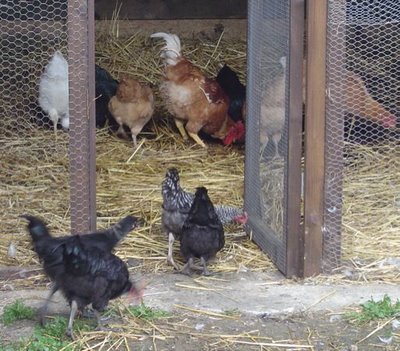
So what is permaculture? Historically, one has to go back to the 1970s to find a couple of Australians, Bill Mollison and David Holmgren, who coined the term. I don’t think they’d claim to have invented it, as such, as a lot of what might be considered permaculture has either been around for a long time and/or sits under the umbrella of other definitions, such as organic gardening, architecture and forestry, amongst many others. What they did, is bring a lot of this extant wisdom together in a design system for the whole, where organic gardening, for example, is a method. It takes a good look at nature, to see how natural ecosystems function successfully and tries to emulate the interconnectivity and beneficial links one finds there. And its goal is to create an ecologically sustainable habitat.
Chinese peasant agriculture is certainly sustainable but might, with our eyes, be considered unremitting drudgery. Modern, highly mechanised, chemical dependant and subsidised farming is certainly unsustainable, both environmentally and ultimately economically as well, although it does provide a lot of food and at minimum price—at least for the moment. Permaculture suggests ways of designing sustainable food production systems, using our knowledge, intelligence and other advantages, such as, for example, different plant combinations not available to previous generations, a positive result of globalisation.
If we compare a modern Western wheat field with the equivalent area of natural forest we can see the inspiration for permaculture. The wheat field must be sprayed with herbicide, covered with nitrogen fertiliser, ploughed, harrowed, mechanically planted, sprayed with pesticides and so on. The natural forest requires no maintenance—no fuel-driven mechanised interventions and no chemical additives—yet will provide much greater biomass per year. Just before we get carried away, let’s remember that a much higher proportion of the output of the wheat field is edible. But what if we designed a nut and fruit orchard, which included many other edible perennial plants, along the natural forest pattern rather than the wheat monoculture? That’s called a forest garden, just one practical example of applied permaculture.
One tiny example of permaculture at work on our site, is our use of chickens to tidy up the goose house. As we lifted the dirty straw bedding in one of our weekly cleans, we noticed some maggots and a few other creepy-crawlies. Not sure whether they would create a problem for our geese, we wondered what we should do. Applying a little permaculture, we coaxed the chickens into the goose house, where they spent some happy hours scratching away at the floor and eating the bugs. We could have spent a lot of our own time and effort cleaning up to the best of our ability and probably applying some chemical product to kill bugs but instead, much as in a natural ecosystem, we just made a link between different parts of our system, problem solved!
